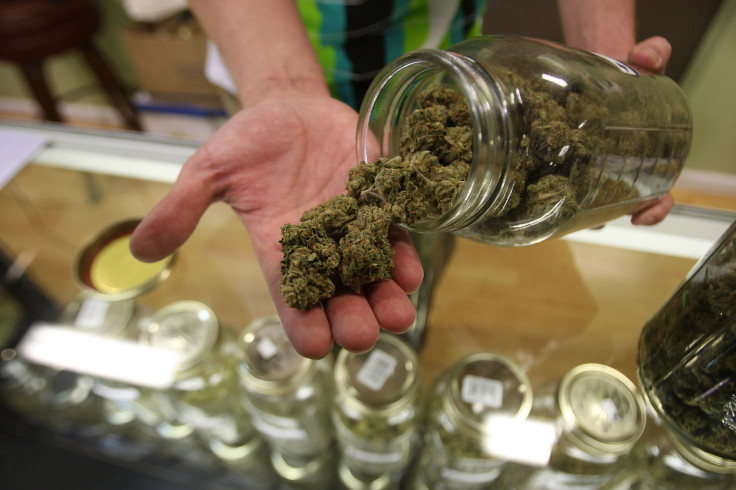The Single Biggest Reason Why US Marijuana Sales Likely Will Skyrocket

There are more U.S. states that allow some form of legalized marijuana than there are states that don't. And the numbers are moving more in that direction. Oklahoma voted just a few days ago to legalize medical marijuana. Voters in Michigan will decide on allowing legal recreational pot in November.
This article originally appeared in The Motley Fool.
An estimated $8.5 billion was spent on legal cannabis in the U.S. last year, according to "The State of Legal Marijuana Markets" report published by ArcView Market Research and BDS Analytics. But this amount could be only a fraction of what's to come. U.S. marijuana sales are likely to skyrocket over the next several years, and there's one big reason why.
Like Dominoes
To understand why increasingly more states are legalizing marijuana, it's helpful to look at the history of lotteries in the U.S. Like cannabis, gambling was frowned upon by authorities in most states for much of U.S. history. In 1964, though, New Hampshire implemented a state lottery, and over the next 15 years, 11 more states legalized them. Today, all but four U.S. states have lotteries.
Why did so many states adopt lotteries after years of banning them? To generate revenue. Imposing steep personal income, property, and sales taxes has never been popular. But states must raise money to fund government operations somehow. Lotteries were a convenient way of doing so without angering a majority of voters.
When one state figures out how to raise money in an easy way, other states take notice. Plenty of states have looked at Colorado, for example. Recreational marijuana became legal in Colorado in 2014. The first year, the state generated $67.6 million in taxes, licenses, and fees from cannabis sales. Last year, that total topped $247 million.
Just as more states implemented lotteries after New Hampshire's success, more states are now looking at legal marijuana as a revenue opportunity. One domino falls and sets off a chain reaction.
How High?
But how high can U.S. marijuana sales actually go? The Marijuana Business Factbook projects that U.S. cannabis sales will reach $22 billion by 2022. ArcView Market Research and BDS Analytics think the total could be even higher, with $23.4 billion in pot sales in the U.S. by 2022.
Those figures don't represent the full economic impact of the marijuana industry, however. ArcView and BDS Analytics estimate that the total economic output of cannabis in the U.S. will be more than $44.4 billion in 2022.
As you might expect, the states with the greatest sales will be those that have legalized both medical and recreational marijuana. California tops the list with projected pot sales of $7.7 billion four years from now. Colorado comes in at a distinct second place, with estimated marijuana sales of nearly $2.5 billion in 2022.
There are a couple of important things to note with these projections, though. First, they only go out a few years into the future. The numbers would likely be significantly larger if projected out through, say, 2030. Second, the calculations only include states that have already legalized pot. Oklahoma, for example, wasn't in the estimates -- but the state votes later this year on legalizing medical marijuana.
Of course, there are also factors that could result in the projections being overly optimistic. Cannabis sales in California so far this year have been lower than expected due to the state's stringent regulations and high tax rates. Some states might find, like California, that taxing pot too much actually results in lower sales.
Potential Winners
I suspect, however, that the projections of U.S. marijuana sales of at least $22 billion won't be too far off. If that happens, we'll be looking at an industry that expands by more than 150% in just four years. That means there will be some big winners.
Most cannabis businesses in the U.S. are privately held. And most stocks of U.S.-based companies in the pot industry are penny stocks -- which come with a laundry list of risks. There are a few U.S. marijuana stocks with market caps of at least $200 million that could be potential winners from a rapidly growing market, though.
Perhaps the most attractive alternatives are the stocks of two companies that provide products to U.S. marijuana growers. Kush Bottles (NASDAQOTH:KSHB) sells packaging products primarily to medical marijuana dispensaries and cannabis growers in the U.S. Scotts Miracle-Gro (NYSE:SMG) sells hydroponics products to cannabis growers through its Hawthorne Gardening subsidiary. Both companies should benefit from the anticipated expansion in the U.S. marijuana market.
Investors should note, however, that Kush Bottles stock trades at a steep valuation as a lot of growth is already factored into its share price. There's also the likelihood that other competitors will enter the market as the U.S. marijuana industry becomes more legitimized. And while Scotts Miracle-Gro should see growth from sales to pot growers, over 90% of the company's business is selling consumer lawn and garden products.
Keep your eyes on the industry, though. It's possible that more private companies will go public. Some of the small penny stocks now trading over the counter could become larger and eventually list on major exchanges. If the U.S. marijuana market grows as much as it likely will, more investing opportunities will emerge.
Keith Speights has no position in any of the stocks mentioned. The Motley Fool has no position in any of the stocks mentioned. The Motley Fool has a disclosure policy.





















